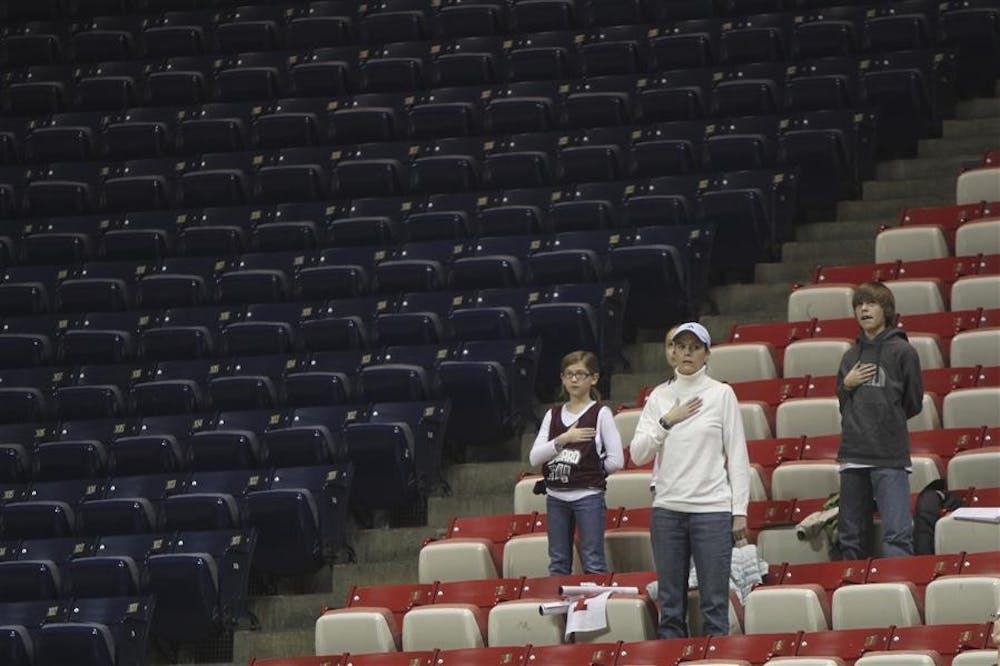On Dec. 5 the Indiana women’s basketball team ended Nebraska’s 37 regular-season game winning streak in Assembly Hall, with 1,628 in attendance.
When the IU men’s team played host to Penn State on Dec. 27, 14,952 people came to watch the Hoosiers as they lost by nine.
Two teams sharing the same storied arena, school name and sport were separated by a difference of 13,324 fans.
At IU and across the nation, the difference between men’s and women’s basketball is clear. The women’s brand of basketball lags behind in the ticket office and television ratings.
IU women’s basketball head coach Felisha Legette-Jack understands her team’s role and accepts it.
“We want you to understand who we are. We are a women’s basketball team, we play under the rim and it’s a beautiful game,” she said. “If you like the Bobby Knight system, you’re going to appreciate us because we’re not the high-flying, dunking team and neither were his teams.”
But the fact still remains that at the beginning of each home game, 14 student athletes run onto Branch McCracken Court, look into the stands and see scattered pockets of fans, which rarely extend past the first few rows of the main level.
Is this a level of normalcy felt only at IU, or are these attendance numbers uniform across the Big Ten?
How the Hoosiers stack up
Last season, IU ranked ninth in the Big Ten for average attendance at home women’s basketball games.
Averaging 2,097 fans a game (12 percent of Assembly Hall’s 17,472 seat capacity), the Hoosier faithful were ahead of Illinois (1,819 fans per game) and Northwestern (973 fans per game). Topping the list was a familiar in-state rival, Purdue.
In the 2009-10 season, the Boilermakers averaged 7,200 fans per game, good enough to fill 50.9 percent of Mackey Arena’s 14,123 seats. Rounding out the list of the Big Ten’s top three fan bases were Michigan State with 41.9 percent and Wisconsin, who filled 32.8 percent of the Kohl Center.
Nationally last year, Purdue and the rest of the Big Ten held their own.
The Boilermakers ranked fifth in the country, while six other Big Ten teams were ranked in the top 50. IU was not one of them.
The Hoosiers’ attendance numbers do not compare favorably with schools from across the conference and country. But who’s to blame?
Is it the women’s basketball program for not having been to the NCAA Tournament since 2002?
The marketing department for not promoting the team enough?
Or does blame rest solely on the IU/Bloomington community, who fail to consistently attend games?
The answer is not so black-and-white.
What’s winning got to do with it?
On Feb. 10, 2009, ESPN.com columnist Pat Forde wrote a column entitled “Hoops schools vs. non-hoops schools.” In the column, Forde analyzed the steadily high attendance of traditional men’s basketball powers such as IU against those programs which didn’t enjoy such a rich history.
Forde found that during that 2008-09 season, the Hoosier faithful continually packed Assembly Hall while Arizona State (not normally a basketball power) enjoyed a top-25 ranking, but failed to draw IU’s attendance numbers.
To show a correlation (or lack thereof) between winning and attendance, Forde calculated the difference between attendance and winning percentage.
While applying this formula to Big Ten women’s basketball in the context of this article, the difference will be named a “fan score.” The higher the fan score, the better it reflects on a school’s attendance.
For example, last season, Purdue finished fifth in the Big Ten and had an overall record of 15-17. On average, their fans filled 50.9 percent of Mackey Arena and earned a 46.8 winning percentage.
Their fan score of 4.1 reflects strong fan loyalty despite a non-winning percentage. However, Purdue Associate Sports Information Director Sara White said this number can be deceiving.
“Last year was Purdue’s first losing season in 25 years. The history of success plays a big factor (in attendance),” White said.
Elsewhere, Ohio State finished first in the Big Ten last season. However, their fan score of -63.7 is significantly worse than the Boilermakers. The Buckeyes were winning, but not many people were there to see it.
IU’s fan score was not as low as Ohio State, but it would have been if Assembly Hall fit 19,500 patrons like Value City Arena in Columbus. Whereas the Boilermakers had a lot of fans but didn’t win a lot, and the Buckeyes won a lot but did not host many fans, the Hoosiers neither won nor drew fans.
With a fan score of -34 last season, the Hoosiers won 46 percent of their games, but filled 12 percent of Assembly Hall on average.
However, since Legette-Jack’s first season at the helm (2006-07) attendance has steadily grown when Assembly Hall was 8.1 percent full.
IU Senior Assistant Athletic Director for Marketing Pat Kraft recognizes that winning will help attendance, but it does not have to be the sole factor.
“We as a marketing staff and as a department do not concern ourselves with wins and losses. We have to continually keep people involved in all of our sports,” he said. “I’m not naive. When you win, crowds come. But that’s not always the case.. Yes, winning helps the whole process, but our fans that we get there — we average about 2,100 fans — they’re loyal.”
The Marketing Push
As the fan score shows, winning plays a role in a program’s attendance numbers.
But, as Kraft said, it should not be a detriment to a marketing department’s efforts to draw larger crowds.
Realistically, programs across the Big Ten agree on what audience will attend women’s basketball game and who will not.
Wisconsin Associate Director of Athletic Communications Diane Nordstrom said she thinks families are key.
“One thing that we have done at Wisconsin, and it has worked very well, is gear our attendance towards families,” she said. “Making the event more family friendly by making the players available for autographs and kids being able to see the players close up.”
White said she agrees that the same applies at Purdue.
“College students make up a very small percentage of our crowd. It’s a lot of Purdue employees, a lot of retirees, it’s a lot of families with children. We’ve tried to reach out to the students more and more, but honestly it’s a tough sell to the student body in general because if they’re basketball fans, more than likely they’re going to go to the men’s games,” she said. “I’ve been involved with college women’s basketball for over 20 years and traditionally across the country, it’s your older folks and families with children that is your fan base for college women’s basketball.”
Marketing representatives from IU, Wisconsin and Purdue all said they offer special ticket discount packages to draw families to games, promotions with youth basketball teams and a breast cancer awareness game.
However, Purdue separated itself from other schools with the BOILERmaker NETwork.
“The most important factor is the community support, but specifically, the BOILERmaker NETwork, which is the women’s basketball booster organization,” White said. “Their membership is close to 400 people. I know they have drives every year where they encourage members to not only buy season tickets, but to get at least one more person to buy season tickets.”
According to its website, the BOILERmaker NETwork also holds receptions, buses to away games (similar to IU’s Win Wagon) and their own newsletter.
Kraft said one of the main difficulties his department has is reaching out past the Bloomington community.
“And that’s how a lot of our sports are grown: through the local community. When we played last night, that’s a hard game for folks in Indianapolis, Evansville, Fort Wayne or wherever to come to,” he said. “So a lot of our sports — volleyball, soccer, softball — are based out of the Bloomington community.”
Embracing the faithful
No matter what the numbers are, or how they stack up against the rest of the Big Ten, Legette-Jack and her team say they are just appreciative of the loyal fans who show up game after game.
“We do have a lot of loyal fans, fans that come to every single game,” senior guard Whitney Lindsay said. “They inspire us. It does give you a sense of more people are believing in you and more people have your back, knowing you’re about to go into a tough battle.”
Her coach agreed that it is a matter of quality over quantity.
“It’d be really cool to have kids come to Indiana and play in front of our audience of 10,000 plus,” coach Legette-Jack said. “But, we’ll keep the 1,600 that want to be here.”
Attendance at women’s basketball games continues to lag

Get stories like this in your inbox
Subscribe



